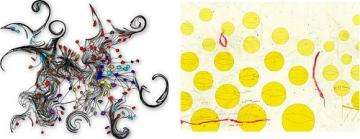October 11, 2007 weblog
Patterns reveal sci-tech ideas at Digital'07 art expo

What does the sound of a Minke whale look like? Is it possible to read secret messages in broken eggs that hide an abbreviated form of binary code?
At Digital’07, a digital print competition and exhibition hosted by Art & Science Collaborations, Inc. (ASCI), viewers can see a variety of science ideas like these represented visually. The exhibition is bringing together art, science, and technology to create a new multi-disciplinary field, sometimes called “art-sci-tech.”
The Digital’07 exhibition is running from October 6 to January 27, and includes both an online showcase and live presentation held at the New York Hall of Science. The exhibit marks ASCI’s ninth annual International Exhibition of Digital Prints, and this year’s theme is patterns.
"For Digital'07, the international Open Call challenged artists, scientists, and technologists to show us digital prints that look at structure and pattern in the universe, whether visible or invisible to the naked eye,” according to the ASCI Web site. “More specifically, this exhibition explores how today's scientific fields of systems science, chaos and string theory, fractals, nanoscience, genetics, molecular science, the wavelets or frequency of sound, and mathematical data-sets, plus nature itself, are being utilized to create two-dimensional art of provocative and sumptuous pattern.”
The ASCI jurors received entries from 116 artists/scientists from around the globe, of which 23 were selected for the exhibition. The artworks display a myriad of patterns, including flower mandalas; computer-simulated patterns for designing road systems or computer networks; computational fluid dynamics simulations in sand dunes, snowdrifts, and riverbeds; fractals; the structural space perceived in space-time; the interplay of creatures from micro and macro realms; chimeras; and more.
As the jurors explained, using art to reveal patterns yields a type of creative expression that continuously reveals new perspectives and ways of thinking, and will hopefully help to increase communication and collaboration between the fields of art, science and technology.
“The creative practitioners represented in this exhibition only just begin to scratch the surface of the almost unfathomable potential provided by digital technologies to mediate traditional patterns and to discover new ones,” said JD Talasek, Director of Exhibitions and Cultural Programs at the National Academy of Sciences.
Cynthia Pannucci, Founder and Director of the ASCI, echoed the sentiment: “In the end, I predict that ‘Pattern-Finding’ will become a highly developed, lively, interdisciplinary artistic genre in the 21st-century,” she said.
ASCI is a grassroots organization founded in 1988 and based in New York City. The organization has global membership of about 400 artists, scientists, professors, curators and writers, and was one of the earliest art-sci-tech member organizations in the United States.
Relevant links:
Cesar Hidalgo -- www.nd.edu/~chidalgo/
Lorraine Walsh -- www.lorrainewalsh.com





















